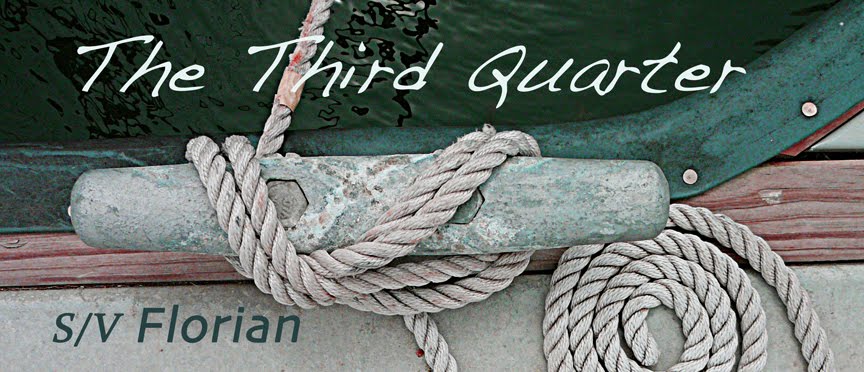 |
| July 1988 s/v Heiress Beaufort, SC with my step dad TC and two friends |
Learning how to sail feels overwhelming at times. The location, function & maintenance of every part on a boat, the nomenclature, the ability to read & interpret currents, weather patterns, charts and
COLREG rules, etc. - all together - it feels akin to learning 4 new languages at the same time. All of that is fine (and fun), but sailing also has some inherent dangers, and I suspect that's the roughest part most newbies have to tame; the fear of not knowing what to do if a situation turns bad.
When I sailed with my step dad TC and two friends in 1988 in Chesapeake Bay (photo above), I was oblivious of danger, as well as sailing in general. I was a student at the time, so I must have thought TC's Cape Dory 31 was my Spring-Break-in-Daytona-Beach, minus the sand. I did a lot of reading, lounging, and cooked an occasional meal. The ships log on day two of our sailing adventure reads "Belinda painted her toenails today - true sign of a vacation... everyone kicked back & reading." If I ever raised the mainsail or tacked, I don't recall, if I hadn't seen photos of myself at the helm, I wouldn't have believed I did anything to help sail the boat. I remember swimming, sunning and lounging. I think wistfully about how much I'd try to learn if I did it all over again. But, I'm on-it now, and having a blast challenging my much-older brain to absorb & recall.
Neural aerobics.
I learn best by watching first, and then doing - repeatedly. I'm grateful to live at a time when I can watch clips about the best boating safety practices online for free. This week, I've been looking at Lifesling. The cover for ours on Florian needed replacing, which got me thinking about how it works. There are
Man Overboard [MOB] diagrams on the front and back, but I wasn't sure about hoisting someone back onto the boat with a spare halyard, so I looked for and found some videos online.
 |
| Man Overboard Rescue demo - pulled aboard in six minutes: video |
 |
| West Marine video about the contents & use of a Lifesling |
This video (two and a half minutes), posted by West Marine, is a great overview of what's in the Lifesling bag, with a brief review of how it's attached to your boat, and a verbal description of how to use it in a man-overboard situation. I'll go out on a limb here and bet that most people put these on their boats because they're supposed to, and likely don't give them a second thought. Kinda like changing the batteries in your smoke detector every 6 months – lots of people think its a good idea but statistically most people don't.
 |
| No one ever plans to fall overboard |
This video (eleven minutes) published by the
Sailing Foundation - the folks that developed Lifesling over 30 years ago - is great because they actually use the Lifesling on a sail boat - sailing upwind, and then downwind - and again in a powerboat. If you're a visual learner, these videos are excellent to review as the summer season begins. (While watching, I couldn't help but feel sorry or the folks that "fell" overboard for the demo because, based on the gray skies and all the pulled-up collars on jackets, it looked like a really cold day to be jumping into the water. Brrr.)
 |
| The Lifesling cover on Florian when she arrived |
 |
| Sea water and sunshine sure does a number on pretty much everything exposed to it. |
 |
| Time to get a new cover. |
 |
Lifesling replacement covers run between $35 (vinyl) and $160 (fiberglass).
We stayed with vinyl. |
 |
| New Lifesling Cover on s/v Florian. |
If I get warm enough to swim in our chilly Pacific, I'll be practicing drills with our Lifesling to help develop muscle memory, and sail boat manuevering. Barring warmer weather and water, I'll practice by tossing a life ring overboard, to get my boat maneuvering skills sharp. I sure don't want to figure it out in a panic when someone has fallen off the boat. :)
Have you ever used a Lifesling, as practice, or in a real scenario?





































